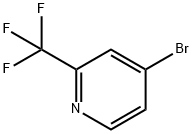4-BROMO-2-TRIFLUOROMETHYLPYRIDINE

|
- ₹0
- Product name: 4-BROMO-2-TRIFLUOROMETHYLPYRIDINE
- CAS: 887583-90-6
- MF: C6H3BrF3N
- MW: 225.99
- EINECS:
- MDL Number:MFCD07774089
- Synonyms:4-BROMO-2-TRIFLUOROMETHYLPYRIDINE;2-(Trifluoromethyl)-4-bromopyridine;4-Bromo-2-(trifluoromethyl);4-Bromo-alpha,alpha,alpha-trifluoro-2-picoline;EOS-61272;4-Bromo-2-(trifL;Pyridine, 4-bromo-2-(trifluoromethyl)-;4-BROMO-2-TRIFLUOROMETHYLPYRIDINE ISO 9001:2015 REACH
| Manufacturer | Product number | Product description | Packaging | Price | Updated | Buy |
|---|
Properties
Boiling point :167.4±35.0 °C(Predicted)
Density :1.707±0.06 g/cm3(Predicted)
storage temp. :under inert gas (nitrogen or Argon) at 2–8 °C
solubility :Chloroform (Slightly), Ethyl Acetate (Slightly)
form :liquid
pka :-1.23±0.10(Predicted)
color :Colourless
Density :1.707±0.06 g/cm3(Predicted)
storage temp. :under inert gas (nitrogen or Argon) at 2–8 °C
solubility :Chloroform (Slightly), Ethyl Acetate (Slightly)
form :liquid
pka :-1.23±0.10(Predicted)
color :Colourless
Safety Information
| Symbol(GHS): |

|
||||||||||||||||||||||||||||
|---|---|---|---|---|---|---|---|---|---|---|---|---|---|---|---|---|---|---|---|---|---|---|---|---|---|---|---|---|---|
| Signal word: | Warning | ||||||||||||||||||||||||||||
| Hazard statements: |
|
||||||||||||||||||||||||||||
| Precautionary statements: |
|
Description
4-Bromo-2-(trifluoromethyl)pyridine is used in the synthesis of a potent and selective Class IIa histone deacetylase inhibitors as a potential therapy for Huntington’s disease.More related product prices
50650-59-4 2-TRIFLUOROMETHYL-4-CHLOROPYRIDINE 2-Bromo-4-(trifluoromethyl)pyridine Ethyl 4-(trifluoromethyl)-2-pyridinecarboxylate 2-Amino-4-(trifluoromethyl)pyridine 2-PYRIDINECARBOXYLIC ACID, 4-(TRIFLUOROMETHYL)-, METHYL ESTER 81565-18-6 147149-98-2 170886-13-2 2-Bromo-5-(trifluoromethyl)pyridine 175205-82-0Related product price
- 50650-59-4
₹8700-20800 - 2-Bromo-4-(trifluoromethyl)pyridine
₹6200-22000 - 2-Amino-4-(trifluoromethyl)pyridine
₹2400-26001.65






